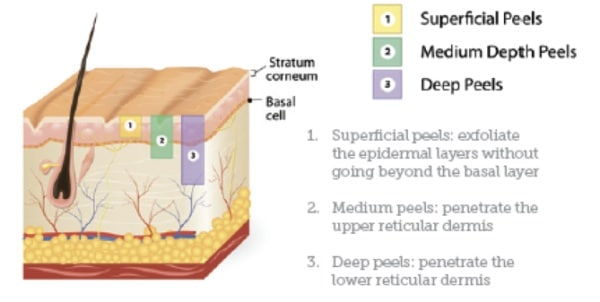
Medium Chemical Peel
Medium chemical peels are an effective way to correct acne scars, address uneven pigmentation, improve the texture and tone of the skin, smooth out fine lines, and more. Medium chemical peels, also known as TCA (trichloroacetic acid) chemical peels, provide more dramatic results than light chemical peels, and they don’t require the extended recovery time of deep (phenol) peels. A medium chemical peel can be used to treat any area of the body and takes only minutes to complete.
What Is a TCA Medium Chemical Peel?
Medium chemical peels penetrate the skin more deeply than light chemical peels. In administering a medium chemical peel, the practitioner applies a solution containing trichloroacetic acid to the skin. This chemical solution, which is custom-formulated for each patient, works by removing the dull, damaged outer layers of skin — those affected by acne, fine lines, sun exposure, and other factors. In the week or so after treatment, these dead layers of skin slough off, revealing a new, smooth layer of skin.
Medium-depth TCA chemical peels work well for treating fine surface wrinkles, superficial blemishes, and pigmentation problems. Similar to the light chemical peel, medium chemical peels require less downtime than a deeper peel. TCA peels are the preferred choice for patients with darker skin.
TCA chemical peels are popular because they are an excellent “spot” treatment that can be used on any area of the body and can be completed in as little as 15 minutes. For best results, patients typically complete a prescribed series of treatments, with each treatment spaced two to three months apart.
This peel excels in providing correction for color irregularities of the skin, whether it’s age spots, sallow complexion, or the dark pigment deposited around the eyes. In addition to color irregularity, it also offers intermediate permanent wrinkle reduction.
A medium-depth TCA peel is less aggressive than a deep chemical peel. Medium-depth chemical peels present an attractive balance between beautiful skin restoration and tolerable post-op care that leaves patients’ skin vibrant and glowing.
Go from Conventional to Contemporary Healthcare.
Call us today at 239-561-9191
What Are the Benefits of a TCA Peel?
- Reduces brown spots, age spots, and actinic keratosis
- Improves the texture of leathery, sun-damaged skin
- Improves skin radiance
- Improve melasma
- Treats some types of acne
- Reduces fine lines
- Increases the formation of new collagen, which can tighten the skin
What Areas Can Be Treated with TCA Peels?
The face, neck, chest, back, arms, and legs. TCA peels may be very cost-effective on the body. However, the risks of problems may also be greater unless the practitioner is very experienced with TCA peels on the body.
When considering peels of non-facial areas, it’s important to realize that these areas do not heal as well as the face, and the desired results are not as predictable. It is important to note that you should never peel more than a small percentage of the body at one time in order to avoid any chance of potential toxicity.
How Long Does a TCA Peel Take?
Depending on the size of the area being treated, a medium chemical peel may take 15 to 60 minutes to complete, though most treatments can be completed within 30 minutes.
Candidates for Medium Chemical Peels
Medium (TCA) chemical peels are known for delivering long-lasting results after a brief healing process. TCA chemical peels are ideally suited to patients wishing to address wrinkles, superficial blemishes and scars, uneven pigmentation (including sunspots), and dark undereye circles. Because TCA peels deliver results beyond those achieved by a light chemical peel, and don’t have the long healing time of a deep (phenol) peel, they are an excellent middle-of-the-road approach to common skin conditions and imperfections.
The TCA Chemical Peel Procedure
TCA peels are performed on an outpatient basis, usually in a doctor’s office. Depending on the concentration of trichloroacetic acid used and the patient’s preferences, light sedation might be utilized, though no general anesthesia is needed.
Medium chemical peels are applied in the same way as light chemical peels or deep (phenol) peels. The skin is first cleansed in preparation for treatment. Then the chemical solution is applied. As with any chemical peel, the specific chemical formulation depends on the patient. This chemical solution is left on the skin for an appropriate amount of time; then the physician washes it away with water and applies a soothing ointment.
What’s in the TCA Chemical Peel Solution
Trichloroacetic acid (TCA) is the active ingredient in a medium chemical peel. The degree and depth to which the TCA penetrates the skin can be adjusted for each patient, as can the concentration of TCA in the chemical peel solution. A 25% concentration may be suitable in some cases. For a slightly deeper penetration, the practitioner may use a concentration as high as 50%.
TCA Chemical Peel Recovery
After TCA chemical peels, a superficial crust forms over the treated area and then flakes off within three to seven days. The newly revealed skin may initially appear reddish, but the discoloration will fade completely within a week, revealing skin with dramatically improved texture, color, and overall appearance. Healing time takes approximately 1-2 weeks.
TCA chemical peel is not without possible side effects. Some mild swelling is common after this type of skin peel. Patients typically do not experience much pain, and any discomfort can be managed with a pain reliever. Although patients can return to their regular activities immediately after a chemical peel, the redness typically takes about a week to fully fade. For this reason, many patients who undergo a TCA chemical peel choose to avoid public activities for about a week.
During recovery, the patient needs to follow the instructions given by the practitioner who applied the TCA peel. The practitioner will provide instructions for limiting sun exposure and taking other precautions after a medium chemical peel.
Are Multiple TCA Peels Required to Achieve Desired Results?
One TCA peel is often sufficient to treat actinic keratosis and sun damage. Individual treatment plans vary, some patients will want multiple TCA chemical peel treatments to achieving optimal results. The number of treatments, as well as their spacing, depends on the patient’s goals, the condition of the patient’s skin, and other factors. For individualized advice, consult a practitioner experienced in administering TCA chemical peels.
Are There Risks with TCA Peels?
Chemical peels rarely result in serious complications, but certain risks do exist. These risks include scarring, infection, swelling, changes in skin tone, and cold sore outbreaks. You can reduce the risks associated with facial peels by following all of the practitioner’s instructions completely and by providing a complete medical history.
